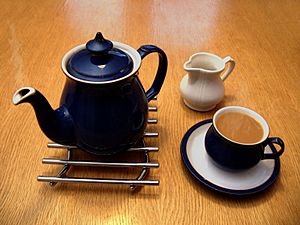Lady tasting tea facts for kids
The Lady Tasting Tea is the name of a famous science experiment from 1935. It was designed by a scientist named Ronald Fisher. This experiment helped explain an important idea in science called the null hypothesis. Fisher's description of the experiment was short and clear. It was based on a real event in Fisher's life. The lady in the story was Muriel Bristol.
Contents
How the Experiment Worked
Muriel Bristol said she could tell if milk was poured into a cup before the tea, or if the tea was poured first. Ronald Fisher wanted to test this special ability.
- He gave her eight cups of tea.
- Four cups had milk added first.
- The other four cups had tea added first.
- The cups were given to her in a mixed-up (random) order.
- Muriel's job was to pick out the four cups that were made one way (for example, the four cups where milk was added first).
- She could taste the cups and compare them.
- She knew exactly how the experiment would be done.
What Was the Null Hypothesis?
In this experiment, the "null hypothesis" was the idea that Muriel Bristol had no special ability at all. It meant that if she guessed correctly, it was just by chance.
- Think of it like this: If someone has no special skill, how likely are they to get the right answer just by guessing?
- The experiment wanted to see if her results were so good that they couldn't be explained by pure luck.
How Were the Chances Calculated?
Scientists needed to figure out the chances of Muriel guessing correctly.
- There were 70 different ways she could have chosen four cups out of the eight.
- Only one of these 70 ways would mean she picked all four correct cups by pure luck.
- This means the chance of getting all eight cups right just by guessing was 1 out of 70. This is about 1.4%.
What Was the Result?
If Muriel correctly identified all eight cups, Fisher would agree that she likely had a special ability. He would "reject the null hypothesis." This means he would say her results were probably not just due to chance.
A colleague of Fisher, H. Fairfield Smith, later said that Muriel Bristol actually got all eight cups correct! This was a very strong result, showing her ability was likely real.
This famous experiment is often used to teach about how scientists design tests and use statistics. A book called The Lady Tasting Tea was written about Fisher's experiment and his ideas on using random order in tests.
See also
 In Spanish: La catadora de té para niños
In Spanish: La catadora de té para niños



